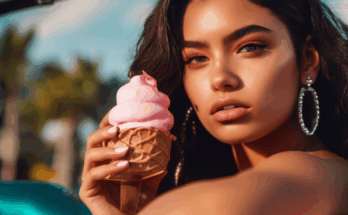Boy bands and girl groups became major players in the music industry in the 1990s. These groups became well-known thanks to their catchy tunes and well-choreographed performances. They were usually made up of young, attractive singers and dancers. The Spice Girls, Destiny’s Child, and TLC were well-known girl groups, while Backstreet Boys, *NSYNC, and 98 Degrees were well-known boy bands. With themes like romance, heartbreak, and personal empowerment that connected deeply with younger audiences, their music dominated radio airplay & chart rankings. These musicians went on to become household names, drawing devoted followings that eagerly awaited new albums and tour dates.
Key Takeaways
- Boy bands and girl groups dominated the 90s music scene, with acts like Backstreet Boys and Spice Girls achieving massive success.
- Pop-punk exploded onto the scene with bands like Green Day and Blink-182, bringing a new energy and attitude to the music industry.
- R&B and hip-hop took over the airwaves, with artists like TLC and Tupac shaping the sound of the decade.
- Grunge and alternative rock had a major influence on 90s music, with bands like Nirvana and Pearl Jam defining the era.
- One-hit wonders made a significant impact on 90s music, with songs like “Macarena” and “Who Let the Dogs Out” becoming cultural phenomena.
- Dance and electronic music evolved in the 90s, with genres like house and techno gaining popularity in clubs and on the radio.
- The legacy of 90s hits continues to influence today’s music industry, with artists and producers drawing inspiration from the sounds of the decade.
Through frequent appearances in media and at high-profile events, the group members attained celebrity status. Their impact went beyond music to include fashion, as their coordinated ensembles and hairdos frequently started movements among their fan base. The music business and larger popular culture were greatly impacted by the 1990s boy band and girl group craze. Their popularity affected pop music’s course during this time and impacted musicians & music lovers in later generations.
Themes of Teenage Rebellion and Anxiety. For a generation of young listeners navigating the difficulties of adolescence, their music resonated with themes of teenage angst, rebellion, and disillusionment. Pop punk: The Unadulterated Power.
Pop-punk music’s unadulterated, raw quality connected with listeners who were looking for a way to express their feelings & frustrations. Pop-punk bands developed a devoted fan base that embraced the DIY mentality and anti-establishment spirit of the genre thanks to their outstanding live performances and rebellious attitudes. Long-Term Effects & Heritage.
In addition to having a profound effect on the music business, the pop-punk explosion of the 1990s opened the door for a new generation of punk-inspired bands in the years that followed. With the emergence of hip-hop and R&B as major forces in popular music, the 1990s saw a dramatic change in the music industry. Rappers like Tupac Shakur & The Notorious B.
followed in the footsteps of R&B chart-topping artists like Mariah Carey, Boyz II Men, & Whitney Houston, who were known for their soulful vocals & heartfelt ballads. Artists that specialized in R&B and hip-hop rose to prominence in popular culture by addressing social issues and pushing for reform with their platforms. Their music frequently addressed themes of love, emancipation, and resiliency, giving voice to underrepresented groups and questioning social norms. The 90s saw the emergence of hip-hop & R&B, which not only revolutionized the music business but also opened doors for a new wave of musicians who are still pushing the envelope and redefining genres.
Grunge and alternative rock emerged in the 1990s as potent musical movements that opposed the mainstream music establishment. Bands like Soundgarden, Pearl Jam, and Nirvana became well-known due to their introspective lyrics and raw, emotional sound. A generation of listeners who were looking for authenticity & emotional depth in their music was resonated with their frequent touches on themes of alienation, disillusionment, & social commentary.
The DIY spirit and countercultural attitude of grunge and alternative rock bands drew in a devoted fan base as a result of their rejection of traditional rock star stereotypes and anti-commercial ethos. Their impact went beyond music, as they came to represent a new generation of youth culture and fashion trends. In addition to having a long-lasting effect on the music business, the alternative rock and grunge movements of the 1990s gave rise to a new generation of musicians who aren’t afraid to break rules and experiment with new ideas. Rise of the One-Hit Wonders.
One-hit wonders became a major phenomenon in popular music during the 1990s. These musicians experienced a brief period of sudden stardom thanks to a single song that went viral and briefly ruled the radio. Famous Songs of the Time. Songs like Los Del Rio’s “Macarena,” “Mambo No.
Lou Bega’s “Loud & Proud” & Chumbawamba’s “Tubthumping” became enduring hits that shaped a generation and lingered in popular culture. With their memorable tunes & captivating hooks, one-hit wonders frequently experienced an abrupt surge in popularity but found it difficult to stick around in the erratic music business. long-lasting effects on popular culture.
These musicians made a lasting impression on popular culture despite their brief fame, with their songs becoming nostalgic anthems that bring back memories of a bygone era. In addition to changing the musical landscape in the 1990s, the influence of one-hit wonders serves as a constant reminder of how erratic success and recognition can be in the entertainment business. As musicians embraced new technology and production methods to create avant-garde sounds that enthralled audiences worldwide, the 1990s saw a significant evolution in dance & electronic music. Dance & rave music became increasingly popular in genres such as house, techno, and trance, thanks to the innovative electronic music of artists like Fatboy Slim, The Chemical Brothers, and Daft Punk.
As a means of escape for those seeking euphoric experiences on the dance floor, dance and electronic music came to be associated with youth culture and live music. A common celebration of music and movement, the genre’s contagious beats and pulsating rhythms brought together diverse audiences across linguistic and cultural divides. As dance and electronic music developed in the 1990s, it changed not only the club scene but also mainstream pop music, opening the door for a new generation of artists who draw inspiration from electronic music and constantly push the genre’s boundaries. With musicians taking cues from the sounds and fashions that typified the decade, 90s hits have a lasting impact on the contemporary music scene. The influence of 90s hits can be heard in contemporary music across genres, from R&B-infused pop stars like Beyoncé and Justin Timberlake to pop-punk revival bands like Paramore and Fall Out Boy.
In addition, a great deal of the music industry’s 90s talent has survived into the present day. Artists like Mariah Carey, Green Day, and TLC have all maintained lucrative careers and are still putting out new music that appeals to both younger & older fans. Backstreet Boys & New Kids on the Block have both had their successful comebacks, & nostalgia for the 1990s has also contributed to a renewed interest in vintage sounds and fashions. The 90s musical landscape is timeless, which is reflected in the longevity of its hits and a testament to the cultural influence of the decade on popular music. It is evident that the influence of 90s hits will continue to shape music for years to come as artists of today continue to pay homage to the sounds that defined a generation.
If you’re a fan of 90s hits, you might also be interested in learning about the retro future of synthwave music. Check out this article on Retro Future 2023: Synthwave’s Comeback and Its Nostalgic Charm to discover how this genre is making a comeback and captivating audiences with its nostalgic charm.
FAQs
What are some of the most iconic 90s hits?
Some of the most iconic 90s hits include “Smells Like Teen Spirit” by Nirvana, “Wannabe” by the Spice Girls, “Waterfalls” by TLC, “Wonderwall” by Oasis, and “Baby One More Time” by Britney Spears.
Which music genres were popular in the 90s?
The 90s saw the rise of various music genres, including grunge, hip-hop, R&B, pop, and alternative rock. Each genre produced numerous hits that defined the decade.
What impact did 90s hits have on popular culture?
90s hits had a significant impact on popular culture, influencing fashion, language, and social trends. The music of the 90s continues to be celebrated and remembered for its cultural significance.
Who were some of the most influential artists of the 90s?
Some of the most influential artists of the 90s include Nirvana, Tupac Shakur, Mariah Carey, Madonna, and Dr. Dre. These artists shaped the music landscape of the decade and left a lasting impact on the industry.
How did 90s hits contribute to the evolution of music?
90s hits contributed to the evolution of music by pushing boundaries and blending different genres. The decade saw the emergence of new sounds and styles that continue to influence contemporary music.



